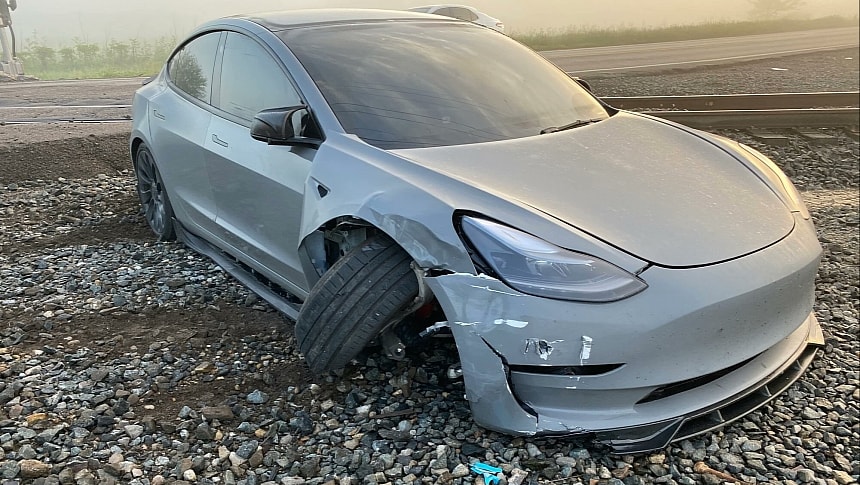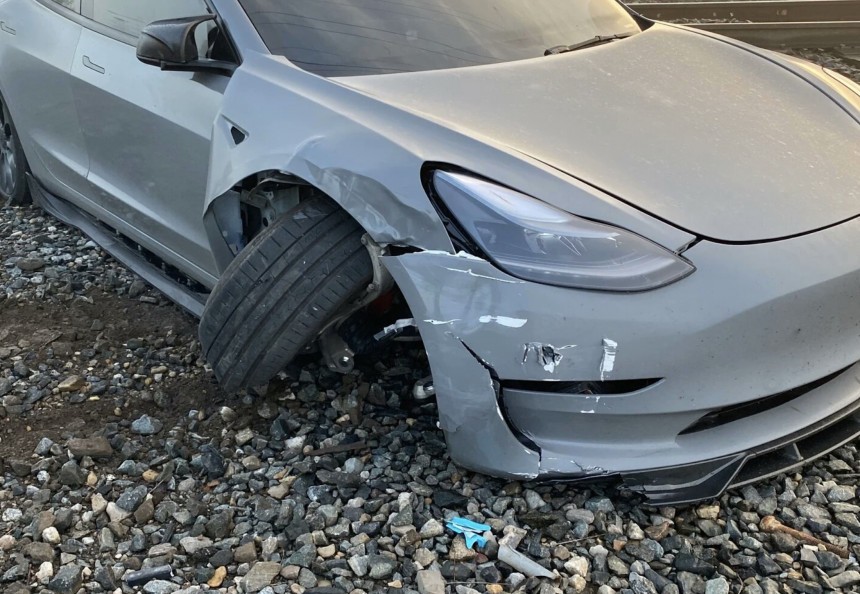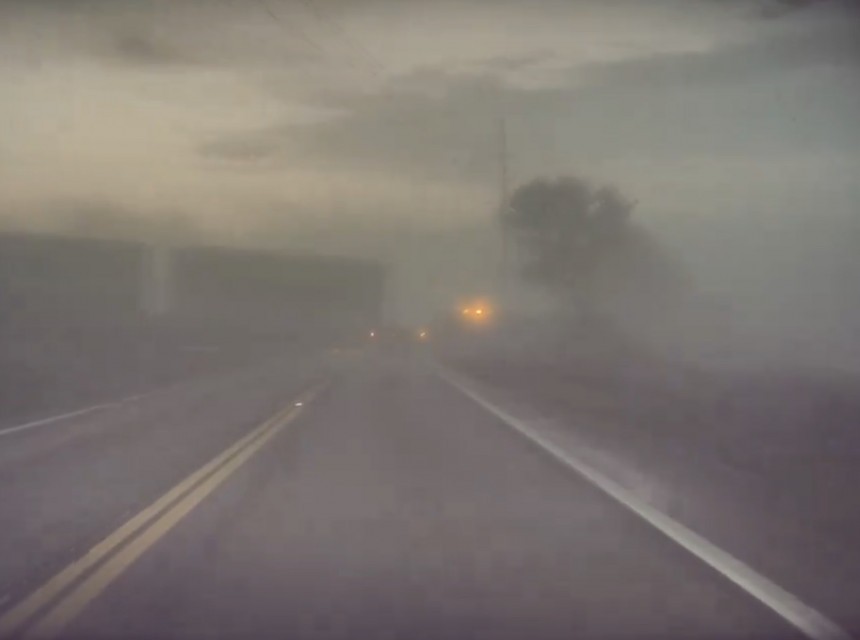A Tesla Model 3 with the Full Self-Driving function engaged almost drove into passing trains twice in the past six months. The owner of the compact sedan has the video captured by the onboard camera to prove that he was terribly close to death.
Reliable or not, the FSD is supposed to brake when it detects obstacles, be it pedestrians, other cars, or just a simple curb on the side of the road. However, the driver must stay alert all the time.
Luckily, this one did (eventually), because he managed to overrun the system and swerve right every time. Otherwise, we would probably be talking about him in Past Tense.
The last time his Tesla was about to kill him was May 8, 2024. The dash cam footage shows how the car suddenly turned right and crashed into a pole, but the driver luckily escaped with minor injuries. The Model 3, though, suffered significant damage to the front end.
The bumper cracked, the suspension was torn apart, and the passenger side front fender was dislocated, while the side sill was ripped off. There is no image from inside the cabin, so we can't tell if the airbags were deployed in the impact.
We can, of course, find excuses for the FSD, pointing our finger at the foggy weather, which would normally reduce the ability of the cameras that equip the vehicle to detect obstacles due to reduced visibility.
However, there is no sign of braking at all as it approaches the railroad, which indicates that it hasn't even detected the signs prior to the train crossing or the flashing lights meant to alert the drivers. At the very last moment, the driver realizes that his car is not going to stop in time, he takes the wheel and swerves right.
The owner originally uploaded the video to the Tesla Motors Club forum before it went viral, sparking controversy. Many social media users blame him for passing on the complete responsibility of driving to the FSD, especially in such poor weather conditions.
However, even if he overran the system late, hoping that his car would stop in time, he did pay the necessary attention to save his life. Luckily, no other vehicles were involved.
The driver had owned the Tesla Model 3 for a year. Within 12 months, his car failed to respond to passing trains twice at different rail crossings. He is now in search for other Tesla owners who have been through similar experiences. He was originally planning to sue Tesla and seek damages, but he had to deal with reluctant attorneys since there was no evidence of "significant injuries."
The driver has an excuse for failing to take control of the car earlier. He explains that, after using the Full Self-Driving system for a while, you tend to trust it to perform correctly. In both cases, he assumed that the Model 3 would slow down. But it didn't, and he was inches away from a tragedy.
There was on more error that the car made prior to trying to try to go head-first into the passing train. According to the owner, it did between 61 and 63 mph (98 - 101 kph) in an area with a speed limit of 55 mph (89 kph).
The Tesla owner claims that this speed was "consistent with normal traffic flow" and it is also the speed that he usually sets cruise control at regardless of the car he drives. This might also be a factor that drives attorneys away from the case.
As indicated by the automaker, drivers must always pay attention to the road, keep their hands on the steering wheel, and be prepared to take immediate action. But we have seen drivers sleeping on board Teslas while on the move or even wearing Apple Vision Pro on the highway, having failed to understand that the system needs constant human supervision.
"The currently enabled features do not make the vehicle autonomous," Tesla explains, despite what some drivers may think.
Advanced Driving Assistance Systems (ADAS) are, indeed, capable of adjusting speed in compliance with the speed limit in the area or adapting it to the traffic flow, braking, or changing lanes. They are also capable of parking the car, moving in and out of a tight parking space by itself, or even driving to the owner's location in a parking lot, maneuvering around obstacles. But that is as far as the FSD goes.
But they are not perfectly reliable, and it is enough for them to fail once. For the past few years, we have constantly reported about tragedies involving Tesla cars driving on Autopilot or FSD.
Luckily, this one did (eventually), because he managed to overrun the system and swerve right every time. Otherwise, we would probably be talking about him in Past Tense.
The last time his Tesla was about to kill him was May 8, 2024. The dash cam footage shows how the car suddenly turned right and crashed into a pole, but the driver luckily escaped with minor injuries. The Model 3, though, suffered significant damage to the front end.
The bumper cracked, the suspension was torn apart, and the passenger side front fender was dislocated, while the side sill was ripped off. There is no image from inside the cabin, so we can't tell if the airbags were deployed in the impact.
However, there is no sign of braking at all as it approaches the railroad, which indicates that it hasn't even detected the signs prior to the train crossing or the flashing lights meant to alert the drivers. At the very last moment, the driver realizes that his car is not going to stop in time, he takes the wheel and swerves right.
The owner originally uploaded the video to the Tesla Motors Club forum before it went viral, sparking controversy. Many social media users blame him for passing on the complete responsibility of driving to the FSD, especially in such poor weather conditions.
However, even if he overran the system late, hoping that his car would stop in time, he did pay the necessary attention to save his life. Luckily, no other vehicles were involved.
The driver had owned the Tesla Model 3 for a year. Within 12 months, his car failed to respond to passing trains twice at different rail crossings. He is now in search for other Tesla owners who have been through similar experiences. He was originally planning to sue Tesla and seek damages, but he had to deal with reluctant attorneys since there was no evidence of "significant injuries."
There was on more error that the car made prior to trying to try to go head-first into the passing train. According to the owner, it did between 61 and 63 mph (98 - 101 kph) in an area with a speed limit of 55 mph (89 kph).
The Tesla owner claims that this speed was "consistent with normal traffic flow" and it is also the speed that he usually sets cruise control at regardless of the car he drives. This might also be a factor that drives attorneys away from the case.
The Full Self-Driving Capability requires the driver to keep eyes on the road
The Full Self-Driving Capability has got it all wrong right from the start. Even though the system is basically just a Level 2 autonomous driving system, its name may suggest to drivers that they can fully rely on the function to drive the car and take on all driving responsibility. However, a look at the manual makes it clear.As indicated by the automaker, drivers must always pay attention to the road, keep their hands on the steering wheel, and be prepared to take immediate action. But we have seen drivers sleeping on board Teslas while on the move or even wearing Apple Vision Pro on the highway, having failed to understand that the system needs constant human supervision.
"The currently enabled features do not make the vehicle autonomous," Tesla explains, despite what some drivers may think.
Advanced Driving Assistance Systems (ADAS) are, indeed, capable of adjusting speed in compliance with the speed limit in the area or adapting it to the traffic flow, braking, or changing lanes. They are also capable of parking the car, moving in and out of a tight parking space by itself, or even driving to the owner's location in a parking lot, maneuvering around obstacles. But that is as far as the FSD goes.
But they are not perfectly reliable, and it is enough for them to fail once. For the past few years, we have constantly reported about tragedies involving Tesla cars driving on Autopilot or FSD.
Cameras are good enough for FSD - Elon Musk.
— Artem Russakovskii (@ArtemR) May 19, 2024
Unless you don't want to get hit by a train.
"I have owned my Tesla for less than a year, and within the last six months, it has twice attempted to drive directly into a passing train while in FSD mode. The most recent incident… pic.twitter.com/XAQccItBYw







